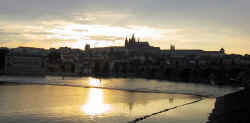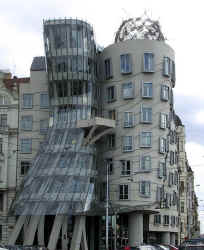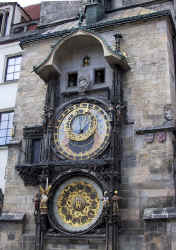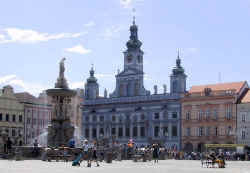Prague
I planned to stay in Praha (Prague in English) for five days. However, it
took me three checkouts before I escaped from the Boathouse Hostel. It was
the Hotel California all over again. You would stay too, once discovering
that beer is cheaper than water. Really good beer at that, since the
Czechs created Pilsner lager (in Plzen of all places).
Now that I think about it, it was probably the night life. Things don't
pick up until after midnight, and they go until daybreak. Since you have
to sleep past the 10 am checkout, this creates a viscous cycle from which you
cannot escape.
In general, Praha is seductive (once you learn to ignore all the other
tourists). Two out of three people I met
here changed their plans at least once
to extend their stay. Prague's skyline is dominated by the castle on
the west side. Though the castle itself is unremarkable, the St. Vitus
Cathedral is quite impressive. A gothic building, half of the structure
dates back to the 1300's. The Charles Bridge spans the Vltava, connecting
the castle district to the Old Square. It was finished around 1400, and
supported wheeled traffic until after World War II.
of three people I met
here changed their plans at least once
to extend their stay. Prague's skyline is dominated by the castle on
the west side. Though the castle itself is unremarkable, the St. Vitus
Cathedral is quite impressive. A gothic building, half of the structure
dates back to the 1300's. The Charles Bridge spans the Vltava, connecting
the castle district to the Old Square. It was finished around 1400, and
supported wheeled traffic until after World War II.
Baroque, Rococo, and Cubism abound in Prague, though the Dancing Building is a modern addition, designed by Frank Gehry and a
though the Dancing Building is a modern addition, designed by Frank Gehry and a  Czech
architect whose name escapes me. Charles IV decided to build up the city
to be the jewel of the Holy Roman Empire--since he was the emperor, he could
pretty much do what he wanted. On the right are rococo facades facing a
statue of Jan Hus, a church reformer who predated Calvin and Luther, who was of
course executed for speaking out against the church. The protestant
movement used his sermons a century later when the world was more ready to
listen. Also in this square is the Old Town Hall, not to be confused with
the "New" Town Hall of the Defenestration of Prague (actually there
have been three apparently). The New Town Hall is no longer new (by
centuries), nor the town hall any more.
Czech
architect whose name escapes me. Charles IV decided to build up the city
to be the jewel of the Holy Roman Empire--since he was the emperor, he could
pretty much do what he wanted. On the right are rococo facades facing a
statue of Jan Hus, a church reformer who predated Calvin and Luther, who was of
course executed for speaking out against the church. The protestant
movement used his sermons a century later when the world was more ready to
listen. Also in this square is the Old Town Hall, not to be confused with
the "New" Town Hall of the Defenestration of Prague (actually there
have been three apparently). The New Town Hall is no longer new (by
centuries), nor the town hall any more.
Back to the Old Square again... One of the tourological marvels here is
the  Astrological
clock. Every hour the crowds gather to see it ring. It tells four
distinct details of time. First it gives the hour and minute of the day
with standard hands. One of the hands is a sun which moves along the
length of the arm, and crosses into areas which represent daylight, sunrise and
set, and night. There is also a calendar which indicates the day.
Somewhere you can also find the signs of the zodiac and the equinoxes. On
the hour the skeleton figure turns over his hourglass and rings a bell
signifying that we are one hour closer to death. The Minstrel,
Moneylender, and Man with Mirror, representing laziness, greed, and vanity, all
shake their heads in protest. Meanwhile the apostles all march past two
windows at the top. Legend has it that the creator was blinded once he
finished so that he could not reproduce this masterpiece for another
town.
Astrological
clock. Every hour the crowds gather to see it ring. It tells four
distinct details of time. First it gives the hour and minute of the day
with standard hands. One of the hands is a sun which moves along the
length of the arm, and crosses into areas which represent daylight, sunrise and
set, and night. There is also a calendar which indicates the day.
Somewhere you can also find the signs of the zodiac and the equinoxes. On
the hour the skeleton figure turns over his hourglass and rings a bell
signifying that we are one hour closer to death. The Minstrel,
Moneylender, and Man with Mirror, representing laziness, greed, and vanity, all
shake their heads in protest. Meanwhile the apostles all march past two
windows at the top. Legend has it that the creator was blinded once he
finished so that he could not reproduce this masterpiece for another
town.
Five of us rented a car one to see Chesky Krumlov, a UNESCO protected 17th
century village to the south. On the way we stopped in Cherny Budjovice for lunch,
once a silver mining town with a pretty central square. Chesky Krumlov is
a well preserved little village that makes you feel like you are in another
time. I have yet to hear a person regret a trip there, though most regret
leaving. So if you are thinking of heading to Prague, be sure to leave
enough time to visit here as well. And bring your bathing suit to go
tubing in the river!!!
village to the south. On the way we stopped in Cherny Budjovice for lunch,
once a silver mining town with a pretty central square. Chesky Krumlov is
a well preserved little village that makes you feel like you are in another
time. I have yet to hear a person regret a trip there, though most regret
leaving. So if you are thinking of heading to Prague, be sure to leave
enough time to visit here as well. And bring your bathing suit to go
tubing in the river!!!
Floating and rowing a boat on the Vltava is another great way to while away
the time. For a more sobering experience, visit Josevof, the former Jewish
Quarter. Hitler originally intended to create a museum of an exterminated
race here, so he brought many artifacts to Prague. There are several
synagogues converted to museums which chronicle Jewish culture. Again I
would recommend a walking tour for full appreciation of what this city has to
offer.
Next stop: Budapest
 of three people I met
here changed their plans at least once
to extend their stay. Prague's skyline is dominated by the castle on
the west side. Though the castle itself is unremarkable, the St. Vitus
Cathedral is quite impressive. A gothic building, half of the structure
dates back to the 1300's. The Charles Bridge spans the Vltava, connecting
the castle district to the Old Square. It was finished around 1400, and
supported wheeled traffic until after World War II.
of three people I met
here changed their plans at least once
to extend their stay. Prague's skyline is dominated by the castle on
the west side. Though the castle itself is unremarkable, the St. Vitus
Cathedral is quite impressive. A gothic building, half of the structure
dates back to the 1300's. The Charles Bridge spans the Vltava, connecting
the castle district to the Old Square. It was finished around 1400, and
supported wheeled traffic until after World War II. 


